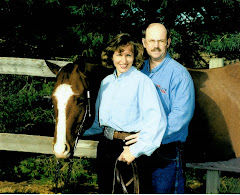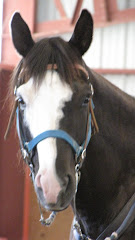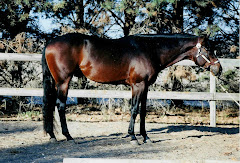MONDAY, October 4, 2010
Duster:
I started the morning with Duster tied to the trailer again. He did fine at the trailer by himself.
Duster was still a little jumpy when the bag touched his flanks and belly. But he stood still as I moved the bag from his hip, down and up his back legs, belly, up and down the front legs, up his neck, and over his poll and down his face.
Peter took Duster and moved him with the horse, asking him to move his hips away. He reached down and moved the stirrups against Duster’s sides. He had me step up into the stirrup, reach over and rub the neck on the opposite side. I had done this the last few days that I had worked Duster at home. He had me rub behind the saddle, as that is where the horse is a little goosey if the rider drags his foot across his back when he mounts and dismounts. I stepped up and down. Then I stepped up and sat down into the saddle. Then stepped down. I stepped back up, sat in the saddle, and Peter had me hold the Cheyenne roll of the cantle with one hand and the horn with the other hand. He moved Duster around with his horse for a minute, than I stepped down. I felt no resistance in Duster. He moved off freely. Duster is ready to start riding at home. Later in the morning, Peter asked if I wanted to ride again or if I thought I had done enough. I wanted to end the clinic with Duster relaxed. I was at a good spot with him and I was happy where I was with him. I accomplished what I wanted to accomplish with Duster. I wanted a young gelding who wasn’t so pushy and was more respectful of moving where he should move.
Shaggy: practice moving the hips around without the reins, moving the hips to both the inside and outside to reverse the horse, at both the walk and the trot, on a very loose rein
We started our last session of the last day with loose reins. We continued to practice moving the hips. Then we moved the horses out at the walk, asking them to reverse by moving their hips to the inside of the rail or to the outside. It was easier to reverse the hips when we were pushing the hips towards the center and the head went towards the rail. It was more difficult with Shaggy to move his hips to the rail and have his head come to the center. Once he started moving his head towards the center, he would walk a very large circle to reverse, instead of swinging his hips in toward the center. This should have taken a few steps, like a forehand turn on a long loose rein, not a large slow circle.
Peter said that they will blink as they move their hips - each time they step around in a half circle to reverse, they will blink with each step. This is a “ah ha” moment. And it was fun to watch to see when the horse blinked and when he didn’t. If there was any resistance, or if the horse didn’t move his hips freely, he didn’t blink.
We practiced snaking down the side of the arena - move hips slightly in, then slightly out. This sounds easy, but it was not, especially on a very loose rein.
We ended the clinic with this last exercise - pick up the trot, move the hip out so the horse faces the fence, then ask the front end to move over, with the head and neck level. Always asking for a lightness, asking for the jaw to be down and in, always asking for the head and neck level. Sometimes we stayed at the trot and did ½ circles or full circles. We mixed up the patterns, but it was always about keeping the horse moving. Every now and then, we would pause, but just for 1 second, then continue.
Any time the horse pulled on your hands or lifted his head, we were to stop the transitions, ask for the horse to soften, then continue the transitions. We were to work as fast as we could without “upsetting the horse”. Towards the end of the 4th day, the horses were responding with a quietness and a smoothness that they didn’t have the first day. Feel was developing.
The week after the clinic, it took me days to process and write about everything that we did. I’m not doing anything with my 2 year old This week. I will continue with Duster next week. I should have a few rides on him before I leave him alone until next spring. I will continue the work with Shaggy, as he is ready and more mature to continue on. My goal this fall is to free up his hips and to move his hind quarters more freely.
I hope you enjoyed this very long read. I have read, and re-read, this about 6 times. The progress on each horse is amazing. The one thing that I’m most impressed with is that both horses became calmer and calmer as their training became more intensified. Over the course of 4 days, they were taught a new exercise, and then we had an hour of repetition. We varied the exercises to keep the minds of the horses fresh. As we worked harder, the horses remained more in focus to us, the rider. It goes to show you that you can work your horse intensely, and by being consistent, you will have a more broke horse. One that is respectful to you.
Come along on the ride with me. “Embrace the Journey!”
Turning Night to Day
9 years ago







No comments:
Post a Comment